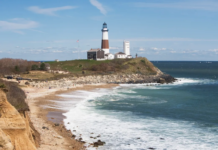This article was produced for ProPublica’s Local Reporting Network in partnership with the Anchorage Daily News. Sign up for Dispatches to get stories like this one as soon as they are published.
RUSSIAN MISSION, Alaska — As the summer months stretched into fall, Justin Edwards would sometimes bump into the man wanted for his attempted murder. In the street or by the schoolhouse or village store.
“He’d say, ‘Hi,’ and act like nothing happened,” said Edwards, 46, who has about 30 shotgun pellets seeded from forearm to bicep in his right arm. Edwards usually said hi back.
“I know that he was on the run,” he said. “But there was nothing I could do about it.”
In this Yukon River village, population 330, residents have long said that if someone is wanted for a serious crime, all they have to do is hide. The Alaska State Troopers might fly in to look for them, but within a few hours the officers would be gone, and even someone targeted in a manhunt could return home like nothing happened.
It took troopers 110 days to catch 20-year-old Tyler Housler, one of three people accused of ambushing Edwards on the edge of the village on July 28. Before he was caught, in November, neighbors said they slept with rifles under their beds and shotgun shells on the windowsill, ready for anything.
It wasn’t supposed to be this way. Two years ago, the Anchorage Daily News and ProPublica documented major law enforcement gaps in rural Alaska. In response, then-U.S. Attorney General William P. Barr declared the public safety crisis in Alaska villages to be a federal emergency and Gov. Mike Dunleavy proposed a spending plan to deliver 15 more troopers to rural communities that cannot be reached by road.
Standing before the largest annual gathering of Alaska Native leaders on Oct. 17, 2019, Dunleavy specifically promised to put state troopers in the villages of St. Michael and Ambler and add officers in rural hub cities in the following year. After that, he told the crowd, the state would add troopers for the first time in recent history in four additional villages: Stebbins, Kobuk, Eek and Chevak.
As Dunleavy, a Republican, prepares to address the group again on Monday, his promises from two years ago have not come to pass.
Instead of growing the number of troopers deployed in individual, isolated Alaska Native villages by one-third in a single year, as promised in budget documents, the number increased only half that much over the past two years, the Daily News and ProPublica found by reviewing trooper staffing and spending plans from the Department of Public Safety.
On top of that, less than $100,000 of the $6 million that the Justice Department gave to the state to combat the lack of public safety infrastructure has been approved for reimbursement to villages.
Credit:
James Brooks/ADN
The months of unease and moments of terror in Russian Mission underscore how little has changed in some isolated communities and highlight the latest in a string of half-filled government promises.
At the time of the emergency declaration in 2019, Alaska’s sexual assault rate was highest in the nation, about nearly four times the national average. Since then, even as the pandemic forced people inside and drove down every other major category of crime, the rate of reported rapes in Alaska has climbed even higher.
“I’m very disappointed, obviously,” said Joel Jackson, president of the Organized Village of Kake. The Southeast Alaska community reported an active shooter last month and waited hours for troopers to arrive. “It’s an ongoing problem for rural communities everywhere,” Jackson said.
In Russian Mission, a Yup’ik village 70 miles from the Western Alaska hub city of Bethel, there has been no longterm, certified police officer since the village public safety officer died by suicide in 2005. In April, it took troopers a week to arrive there to investigate a report of a child being clubbed over the head, kidnapped, bound with duct tape and sexually abused. No law enforcement came to the village until the offender tried to take another child.
Credit:
Bill Roth/ADN
The Western Alaska region is so understaffed by troopers that sergeants based there have reported delayed response times to calls for help and sometimes no response at all, according to a July 2020 study by the University of Alaska Anchorage’s Alaska Justice Information Center.
A spokesman said Dunleavy was not available to answer questions about his 2019 speech promising troopers in specific villages. The governor’s office deferred questions to Public Safety Commissioner James Cockrell.
Cockrell said in a Friday interview that he could only speak to the staffing decisions made since he became head of the department in April, but that troopers face an array of recruiting challenges.
One of the biggest obstacles to placing troopers in villages and hubs, he said, has been finding local housing. The agency has been working to repurpose old National Guard armories and rent Federal Aviation Administration housing in some areas, he said, but was likely unable to secure housing in Ambler and St. Michael.
The state added $20,000 bonuses for new trooper recruits in August, which led to a spike in applications, he said. But the department is still rebuilding from budget cuts that reduced the workforce and forced post closures beginning in 2015, he said.
Cockrell said he is making a “substantial ask” of the governor in his next budget request. In Western Alaska, he said, the department is adding an investigative unit in Bethel and investigators in Nome, Dillingham and Kotzebue. Those additional, specialized troopers might be able to focus on, say, a complicated homicide investigation in the region while patrol troopers handle daily calls in villages.
“Our quality of investigations will be consistent around the state,” Cockrell said. “This is huge, I think. A game changer for the department.”
Fending for Themselves
As the pandemic made travel to villages even more difficult, some communities where residents have long desired reliable local law enforcement dealt with active shooters, domestic violence deaths and jailbreaks.
Alaska state leaders have said that the Department of Public Safety would never be able to place a trooper in every village. Local village police officers and tribal police often keep the peace while serving their friends and neighbors. And the VPSO program, intended to draw recruits from rural communities, can provide lifesaving officers guided by regional tribal consortiums. But each year the state of Alaska has an opportunity to dedicate some of the best-trained and best-paid law enforcement to any given community. When two or three troublemakers can essentially hold a village hostage by forcing people indoors, residents say a nearby trooper would make a world of difference.
Daisy Lockwood Katcheak, acting city administrator in Stebbins, said that following Dunleavy’s speech, residents there believed a trooper would soon be placed in the community of 612 people or at least in nearby St. Michael. They worked to find housing in the Norton Sound village and thought there was state funding for the job, she said, but no one ever came. (Cockrell, the state public safety commissioner, said Friday he hadn’t heard about available housing in Stebbins and would reach out to the community to learn more.)
“We had three individuals walking the town with bats and batons. Swinging them at people,” Lockwood Katcheak said of an incident last year. “Our community members had to make themselves become police officers and detain them.”
Things are more peaceful when a trooper is in town, she said.
Stebbins has a small force of VPOs who were able to arrest one of the three men attacking people in May 2020, but the others armed themselves with steel pipes and broke into the jail. They held down a local police officer and freed their friend, according to charges later filed in state court.
It was up to the community to catch all three. Lockwood Atcheak said the officer who was attacked, her nephew Troy Lockwood, later had a hard time with depression and anxiety. In October, he too was arrested, on charges of attempted murder. (Lockwood had been working as a tribal police officer, his aunt said, paid with CARES Act funds. He pleaded not guilty and declined an interview request.)
When there are no other options, communities like Stebbins have at times resorted to hiring people with criminal records as local police or simply handling troublemakers themselves. Lockwood was working as an officer in 2020, for example, despite convictions for domestic violence assault in 2016 and 2018.
The difference between having VPOs and troopers is stark. VPOs are hired by local governments to enforce city laws like curfews but often end up responding to all manner of public safety emergencies. They are unarmed and not paid much, earning $15 an hour in Stebbins and as low as $10 an hour in some villages. Troopers are highly trained state employees whose pay starts at $75,000 a year.
Stebbins is not the only town that was promised a trooper and hasn’t received one.
A few hundred miles to the north, between the Kobuk River and the Brooks Range, the state is backing a proposal to spend hundreds of millions of dollars to build private roads and bridges to make it easier to extract the region’s rich copper, zinc and gold deposits. In the nearby village of Ambler, a man called state troopers early one morning in July to report someone was shooting at his house. Forty minutes later a different caller said the same shooter had put a rifle barrel to the caller’s face and threatened to kill him. A trooper flew 130 miles to the village, arriving four hours later to investigate. The man was at home, asleep in his bed, when the trooper showed up.
In St. Michael, population 383, another year ends without an arrest or explanation in the 2017 death of a 19-year-old woman. She had been preparing to leave for college before her body was found on the beach, a local mystery that made no national headlines even though her family believes she was beaten to death and the killer or killers still live nearby.
“It’s like an open wound that can’t shut,” said Lockwood Katcheak, who said the young woman, Chynelle “Pretty” Lockwood, was her niece.
“The not knowing part is what’s killing us. The not knowing, and that person’s still out there,” she said.
A Department of Public Safety spokesperson said that troopers investigated the case as a homicide and forwarded their findings to prosecutors. The Department of Law decided not to file charges, citing insufficient evidence, a spokesperson for that agency said.
Credit:
Bill Roth/ADN
Dunleavy told the Alaska Federation of Natives conference in 2019 that the state expected to hire 35 new troopers in 2020 to fill positions in rural Alaska. As of October 2021, the number of working troopers — not counting vacancies — has increased by only 10 statewide. Funding for troopers in St. Michael and Ambler was included in each of the governor’s past two budgets, but the positions were left vacant, meaning no troopers were actually posted in the villages.
Department of Public Safety officials said the money intended for those village troopers was likely spent on personnel costs such as overtime.
The number of active troopers decreased by two in the fall when a Soldotna-based trooper was arrested Oct. 13 on seven charges of sexual abuse of a minor and a Palmer-based trooper was arrested Nov. 15 on multiple charges of felony domestic violence assault. Both have pleaded not guilty.
In a state where influenza epidemics nearly wiped out entire Alaska Native communities a century ago, one of Dunleavy’s efforts to recruit more law enforcement has been to invite police officers who were fired for refusing to be vaccinated against the coronavirus to come work in Alaska.
In the meantime, communities continue to face down active shooters while waiting hours or days for troopers to arrive.
After a man emptied a pistol early in the morning on Nov. 2 in the Tlingit village of Kake, people saw him walking toward the school with a rifle. Jackson, the tribal president, said a trooper on the phone asked him to grab a couple of other men and do a welfare check on the shooter’s mother.
Jackson said no. “I wouldn’t do it. I wouldn’t put other people’s lives at risk either.”
That morning he had considered calling the Department of Fish and Game, instead of troopers, and telling them that someone had illegally shot a moose in the village. “He would have been out here at first light, or even before.”
A trooper spoke to multiple people in Kake that morning, a Department of Public Safety spokesman said. “Troopers advised residents to only take action to apprehend (the man) if it was necessary to defend themselves or others.”
As for the notion that troopers could have responded faster, the spokesman wrote that officers chartered a flight to the village at first light from Juneau, the closest trooper post. “There was no faster means for either the Alaska State Troopers or Alaska Wildlife Troopers to respond to this incident.”
Cockrell said he plans to travel to Kake soon to discuss public safety with residents there.
“I’ve Got Guns and Blades Ready”
Credit:
Kyle Hopkins/ADN
The monthslong manhunt in Russian Mission started with an ambush over painkillers. That’s what Edwards, the shooting survivor, figures that Tyler Housler and two others were after when they attacked him in the early morning hours of July 28.
“They thought I had pain medication on me. Tramadols,” said Edwards, referring to a prescription pain medication that is sometimes ordered online and received by mail in Alaska villages. “They were trying to rob us.” (The charges against Housler and others make no mention of a motive for the shooting. Through the Alaska Department of Corrections, Housler declined an interview request.)
Charges filed in state court say Housler, Jalen Minock, who was 20 years old at the time, and a then-14-year-old boy ambushed six people along a trail that leads into the village. Edwards was standing next to his 8-year-old daughter when he was shot, he said.
Another of the people ambushed, Simeon Askoak II, said that once the shooting started he and others ran to his house at the end of the trail, where the shooters fired into his home as children lay prone inside. Pellets lodged in the wall. The chimney pipe from the wood stove, in the center of the room, is shiny with pockmarks.
Whenever the family cleans the living room, it finds more shotgun pellets.
Credit:
Kyle Hopkins/ADN
Askoak is the son of the last VPSO to work in Russian Mission. Simeon Askoak I had testified before a panel created by Congress to look into the lack of police in rural Alaska in 2005, then two days later he shot and killed himself near the same trail where the ambush occurred.
“I’ve got guns and blades ready, thinking about protecting my family,” his son said recently.
Credit:
Kyle Hopkins/ADN
Even as he was wanted for attempted murder and the subject of a sporadic Alaska State Troopers manhunt, Housler walked free in Russian Mission. During that time, Russian Mission residents said they never knew what might happen. In November, Housler and others are charged with terrorizing the village, invading a home across the road from the school, beating a man inside and threatening to murder the occupants.
One family fled to Bethel. The village health aide quit and moved away, residents said.
Credit:
Kyle Hopkins/ADN
Troopers said they visited the village and neighboring communities, multiple times looking for Housler and the others charged with attempted murder.
“AST went back to the village numerous times in an attempt to arrest the suspects,” the agency wrote in an online dispatch. “Tyler Housler was observed on several occasions to take a boat and flee in extremely hazardous weather conditions on the Yukon River. On one attempt AST rented a boat and driver and went upriver checking fish camps and sloughs but were unable to locate the suspects. AST has also used borrowed ATVs to check fish camps and outlying areas of the village.”
Troopers and U.S. Marshals arrested Minock on Aug. 4 when they traveled to Russian Mission and surrounded his house.
“Jalen eventually bailed out the window and we apprehended him,” said trooper Lt. Lonnie Gonzales, who is based in Bethel. Minock has pleaded not guilty to 15 felony charges included attempted murder, robbery and assault. The 14-year-old suspect also was taken into custody at his home, troopers said.
A woman who described herself as an acquaintance of Housler’s and who asked to remain anonymous for her protection said he went to hide in the hills and bluffs around the villages when troopers came. She said one of Housler’s friends, Stephan “Blacky” Duffy, would keep an eye on incoming flights using an aviation app or website.
Things escalated on Nov. 10 when, according to troopers, Tyler Housler, his brother Bryce Housler and Duffy “were involved in assaulting and strangling at least three victims in separate events.”
One young woman said the three ambushed her and her boyfriend and threatened to kill her. “Tyler said he’d hunt me down like an animal,” she told troopers. Another woman, who is pregnant, said Tyler Housler rammed a snowmobile into her family’s home and told her to look in his eyes, threatening to shoot her. (Bryce Housler and Duffy also declined interviews through the Department of Corrections.)
During the home invasion, as many as 50 people crowded into the nearby house of a local teacher who had planned a memorial feast. The adults crouched below windows in case shooting began and placed children far from the walls, around the dinner tables filled with spaghetti, Mongolian moose meat and akutaq. Two young men with rifles stood guard at the house that night, the teacher said.
The Russian Mission school locked its doors for days while the shooters were on the loose, said another teacher at the school, Steve Jennette.
“One of the kids that got arrested was a student here last year and threatened to kill me,” Jennette said. He said the boy was angry about having his phone taken away at school.
“He pointed at us with his hand, like making a gun and shooting at us. He said, ‘I will come to your house,’” Jennette said.
Troopers arrived in Russian Mission at 6 p.m., Nov. 15, and arrested Tyler Housler, Bryce Housler and Duffy. Tyler Housler pleaded not guilty to more than 40 charges, including a new charge of attempted murder related to the November assaults. Duffy has pleaded not guilty to 10 felony charges including assault, robbery and burglary. Bryce Housler pleaded not guilty to attempted murder, robbery, assault and harassment.
Unspent Money
A 2019 investigation by the Daily News and ProPublica found 1 in 3 Alaska communities had no local law enforcement of any kind.
By the end of that year the Department of Justice had vowed to spend tens of millions in funding public safety in Alaska.
Asked for an accounting of that spending, a Department of Justice spokesperson provided a two-page list of grants and awards to the state, tribes and individual villages, including money for victim services, renovating buildings and the hiring of VPSOs. Much of the funding, $42 million, fell under federal grant programs that were active before the emergency declaration but that the Justice Department described as additional funding for Alaska.
An additional $7 million was awarded through the Justice Department’s Office for Victims of Crime and transferred to the Denali Commission, an independent federal agency, which was to distribute the money using a “micro-grant” program.
The commission, established by then-Sen. Ted Stevens, who died in 2010, has an annual budget of about $20 million and distributes money to improve infrastructure in rural Alaska. The top executive for the commission resigned in April 2020 after four female employees filed civil rights complaints against him.
As of Nov. 30, the commission had allocated only $978,000 of the $7 million in federal emergency funding for Alaska crime victims, with an additional $913,000 in grants pending. About $525,000 of the $7 million will go to overhead costs of distributing the grants. Only 13 communities or tribes have submitted applications to date.
The villages of Russian Mission, St. Michael and Stebbins were eligible for the funding but did not apply, according to the Denali Commission. Commission Federal Co-Chair Garrett Boyle said the first round of grants were limited to applicants who had not recently received certain federal victim services funds. Eligibility was expanded for the second round of grant awards.
An additional $6 million in emergency rural public safety money was awarded from the Emergency Federal Law Enforcement Assistance program directly to the state Department of Public Safety. The state awarded that money to tribal consortiums and villages to pay for projects like installing prefabricated public safety buildings in 30 communities. But as of December, only about $93,000 out of the $6 million had been approved for reimbursement.
The projects are behind schedule “due to meeting the numerous requirements in the environmental review process that precedes construction,” said Nichole Tham, operations manager for the Alaska Division of Community and Regional Affairs.
















